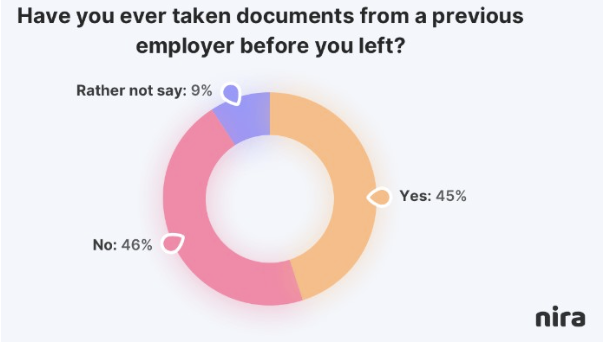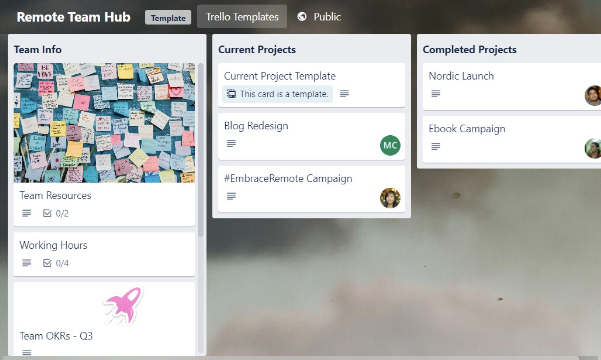Do you feel overwhelmed to stay on top of all HR functions and responsibilities of your remote company? You may have mastered the process of hiring remote workers. But what about the offboarding process when an employee leaves?
Maybe, you’ve not been operating for that long. And you have yet to lose some talent in the future. Knowing how to offboard an employee correctly can save you tons of problems, that’s for sure.
So, let’s go through the importance of effective offboarding and how to apply the best employee exit practices from NoHQ — the go-to advice hub for remote-first and hybrid companies.
What Is Employee Offboarding?
Employee offboarding is a process of well-established steps that lead to the official parting of the employee with the organization. Regardless of how an employee leaves a company — voluntarily or involuntarily, offboarding them effectively calls for completing a series of necessary actions.
Offboarding an employee will likely include:
- signing of documents;
- transferring duty-related information;
- returning of company assets;
- scheduling an exit interview;
- processing final payroll;
- terminating access to company systems.
More often than not, professionally done offboarding should be just as positive as their onboarding experience.
Employee Onboarding vs Employee Offboarding
Employee onboarding is now a long-established workplace practice, which helps new hires adapt to their job role and work environment. Offboarding is the complete opposite of onboarding. It is a formal process that involves sundering the bonds between the employee and the company.
Key differences:
- Duration of time: Both onboarding and offboarding are executed in a phased manner. The onboarding process, however, can take up to 3 months, while offboarding is far quicker.
- Varied Experiences: Ideally, your employee should have a positive experience during their onboarding and offboarding. However, starting new employment makes them feel excited about the future, whereas resigning or getting fired from a job may carry a degree of anxiety for them.
- Level of control: A survey by Nira finds that 45% of departing employees have no qualms about breaching confidentiality. So, you may have less control over the security of sensitive data once an employee leaves, despite minimizing risks during their offboarding. In comparison, you’re confident about employees being on board with confidentiality at the start of the job.

In the remote world, employers onboard and offboard employees by resorting to automation software and EOR service providers, like Multiplier.
Still, some companies continue to invest time and money in devising thorough and efficient onboarding procedures, while making less effort to put comprehensive employee separation policies in place.
This can be a crucial mistake.
Why Is Employee Offboarding So Important?
Well-structured and respectful offboarding benefits both your business and the leaving employee.
Here’s why:
Helps You Maintain A Good Reputation
Considering that 1 in 3 job candidates think twice before accepting a job offer from a company with a bad reputation, why hurt yours by parting with an employee in a rushed or irreverent manner?
People read every online review they come across to make an informed opinion about a prospective employer. With that said, a company’s image among employees relies on their experience throughout the entire employee life cycle, from the first days of their onboarding to their final moments in the organization.
So, offboarding employees gracefully and with respect will not only open the doors for talent referrals and boomerang rehire, it will also boost your brand’s image.
Ensures Legal Compliance And Prevents Security Issues
A well-devised, step-by-step offboarding plan helps you stay compliant with employment regulations. Your staff member may be resigning or retiring, or terminated. Each scenario requires a different approach to protect yourself against potential litigation.
Also, offboarding employees with company data safety in mind is more than vital. A survey by OneLogin found that 20% of their 500 respondents experienced a data breach when they failed to remove former employees’ access to corporate accounts.
Can Be Insightful Through Valuable Feedback
An exit interview is part of the offboarding process. It allows your employee to share feedback on their experience in the company. This, of course, may include the good and the bad. If your employee does have some criticisms, don’t get defensive. It could be relevant information that could help you spot the weak points in your business operations, allowing you to improve upon them.
Surveys are also a great tool for gathering deep insights. Used by office-first, partially remote, and remote-first companies alike, employee exit surveys are especially helpful if you’re experiencing talent retention issues. Conducting them will indicate to the rest of your team that you care about people and the company’s future.
How to Effectively Offboard Remote Employees?
Bidding farewell to a remote employee may sound more challenging than doing it in person. But it doesn’t need to be!
Read our 5 remote-specific tips on comprehensively offboarding an employee:
Step #1: Communicate The News About Your Employee’s Exit
Remote offboarding is a joint effort between departments when done right. Depending on how big your company is, you might need to disseminate the information about the departure across multiple teams.
On that note, make sure that the IT and HR teams have access to your employee offboarding checklist, and that it’s straightforward to follow.
Regardless of whether you rely on asynchronous communication or instant messaging, or use a combination of the two, timely communication is especially important to avoid rumors, security issues, and potentially costly misunderstandings.
Step #2: Make Arrangements for Knowledge Transfer in Due Time
In remote settings, project management and collaboration platforms, like Asana and Trello, make it easy for your departing employee’s completed and in-progress tasks to be accessed at a click of a button.
Still, ensure to tie up any loose ends and ask them to pass on any project-related documentation to their prospective replacement.
Routine work shadowing, for that matter, is a great way to help you assign another team member to step into their role in an instant.

Step #3: Schedule A Virtual Exit Interview
Invite your exiting employee to a friendly video call. Take the opportunity to show your appreciation for their contribution to your team and encourage them to share their honest feedback.
Parting on a positive note with your remote employee is key. Believe it or not, one too many bad reviews from former employees can seriously damage your reputation. Also, don’t forget to offer your exiting team member a letter of recommendation.
Step #4: Remove Access to Company Systems
Don’t risk the safety of company data and intellectual property!
According to the IBM’s 2022 Cost of Data Breach Report, malicious insider (which includes ex-employees) was one of the common causes of compromised data security, costing companies globally $4.18M.
So, revoke access to all company accounts, networks, and systems without delay. Last but not least, remove your departing employee from any group meeting lists, so they stop getting future invitation emails.
Step #5: Prepare Exit Documentation And Process Final Pay
Finalize the remote employee offboarding process with a follow-up email that details important exit paperwork and final payroll procedures. Instruct your HR and payroll teams to answer any of their questions, related to due pay, benefits, etc.
Advise your remote employee to refer to your company employee handbook again if need be and read any relevant clauses, especially if they’re getting terminated.
Conclusion
Employee offboarding is a vital element of an employee’s life cycle. When done effectively, it helps you mitigate security risks, reduce disruption to team productivity, stay compliant with employment regulations, and gain valuable insights into the strengths and weaknesses of your business operations and company culture.
It also ensures that the exiting employee feels respected and appreciated for their contribution and time spent in your company. In addition, comprehensive offboarding can be viewed as an invaluable tool for maintaining your brand reputation.
Along with applying remote-specific employee offboarding practices, Remote OK and remote-first companies take advantage of a range of automated platforms that facilitate employee workflow, including their staff’s onboarding and offboarding.
For more insights, visit NoHQ and explore other helpful remote-related content!
